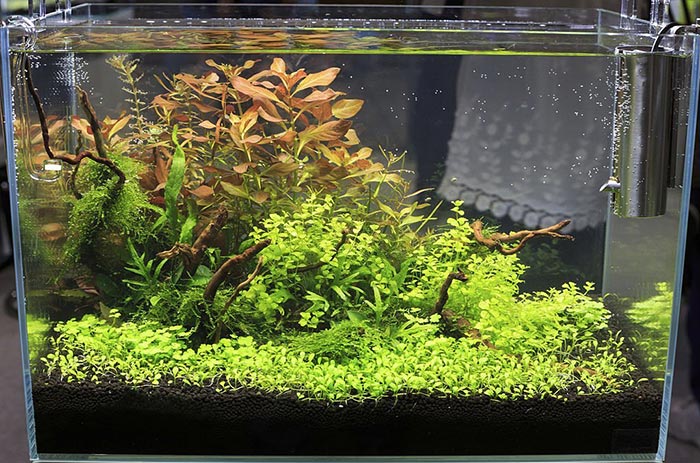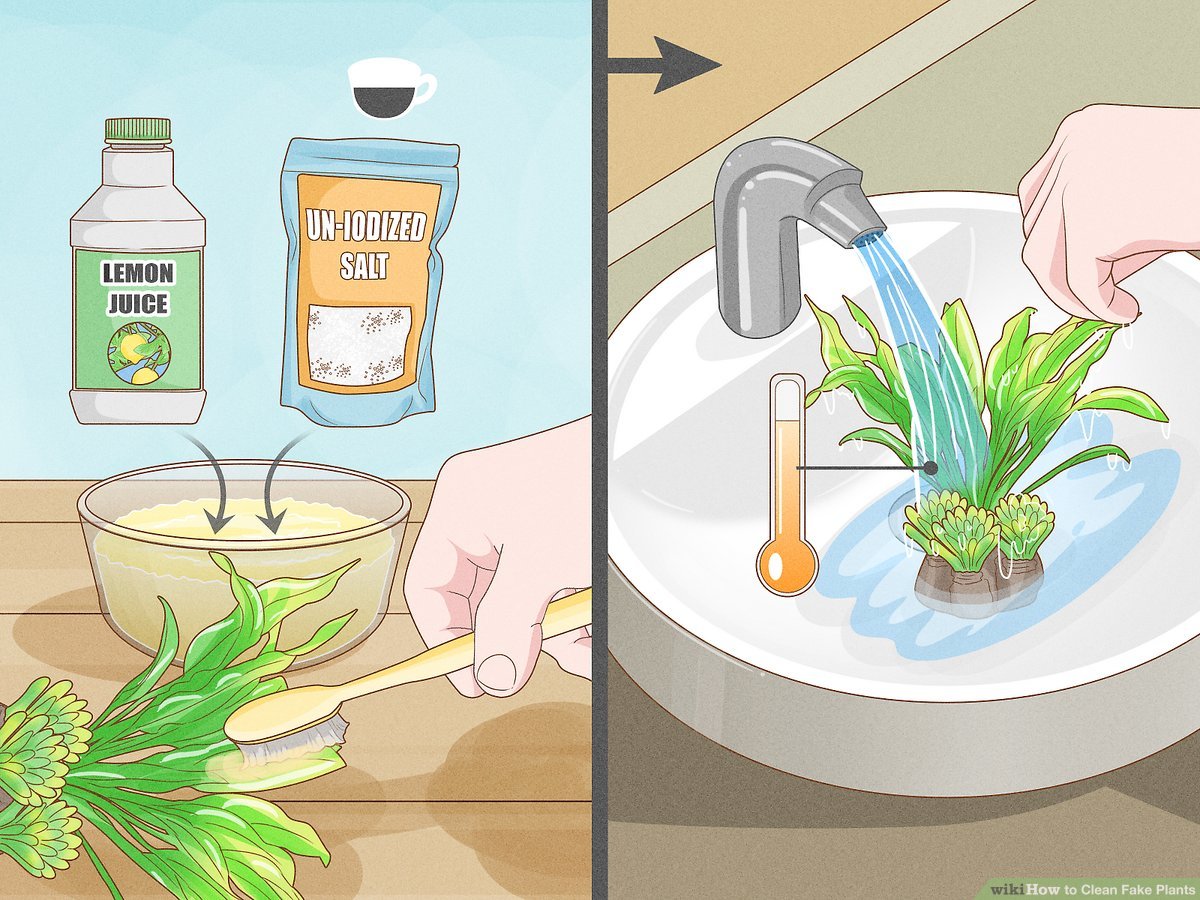To clean aquarium plastic plants, start by rinsing them in warm water. Then, scrub them gently with a soft-bristled brush and a mild non-toxic soap to remove any dirt or algae. Rinse again until all the soap is gone.
Next, soak the plants for 10 minutes in a solution of one part vinegar to four parts water to kill any remaining bacteria or parasites.
Lastly, rinse the plants thoroughly with cold tap water before returning them back into your aquarium. Make sure that you also clean the gravel and other decorations in your tank as well using this same method!
- Step 1: Remove the plastic plants from the aquarium. Place them in a bucket of warm water and add a few drops of dish soap to it.
- Step 2: Let the plants soak for about 30 minutes or until all dirt, debris, algae, etc, has been removed from them.
- Step 3: Rinse off each plant with clean warm water to remove any remaining soap residue.
- Step 4: If necessary, use an old toothbrush to scrub off any stubborn spots on the plants that won’t come off with just soaking and rinsing.
- Step 5: After cleaning your plastic plants completely they should be disinfected before returning them into your aquarium tank in order to prevent contamination of fish or other aquatic life in your tank. To do this place them back into the bucket and add 1 teaspoon of bleach per gallon of water and let soak for 10-15 minutes then rinse well with clean water afterwards before adding back into your aquarium tank.
Cleaning Plastic Aquarium Plants Dishwasher
Cleaning plastic aquarium plants in the dishwasher is a great way to save time and effort. This method is effective because the hot water, detergent, and steam will help remove any dirt or debris from the plants. Using this method regularly can also help keep your tank clean and free of bacteria that can harm fish.
Just be sure to rinse them off thoroughly afterwards as some detergents may contain chemicals that could be toxic for aquatic life if not removed completely!
How to Clean Live Plants before Putting in Aquarium?
In order to keep a healthy aquarium, it is important to clean live plants before placing them in the tank. Before adding any live plants, rinse them off under cold running water to remove dirt and debris. After rinsing, dip the plant in a solution of bleach and water (1 tsp bleach per gallon of water) for one minute.
Rinse off the plant again with fresh cold water before putting it into your aquarium. This will help ensure that no unwanted pests or diseases are introduced into your tank’s environment.
How to Clean Algae from Plastic Aquarium Plants?
To efficiently clean algae from plastic aquarium plants, it is best to first remove the plant from the tank and rinse it in a bowl of warm water. Using an old toothbrush or other soft brush, gently scrub away any visible algae growth. If necessary, use a combination of vinegar and baking soda to help loosen stubborn areas of buildup.
Once all visible signs of algae are gone, be sure to thoroughly rinse the plant with fresh water before returning it back into your aquarium.
How to Clean Algae off Plastic Aquarium?
Cleaning algae off plastic aquariums can be a tricky task, but it is essential for proper tank maintenance. Start by removing any decorations or plants from the tank and cleaning them with warm water and mild soap. Then use an algae scraper to remove as much of the green growth as possible.
Finally, use a sponge or cloth soaked in vinegar solution to wipe down the walls of your tank to eliminate any remaining residue.
How to Clean Live Plants in Fish Tank?
Regularly cleaning your live plants in a fish tank is essential to keeping the water healthy and clear. To do this, start by removing each plant from the tank, being careful not to tear or damage them. Then, rinse each plant with warm water and use tweezers or scissors to remove any dead leaves or stems.
Once complete, place the plants back into their original positions in the tank before topping off with fresh aquarium water.
How to Clean Aquarium Plants Without Bleach?
Aquarium plants add beauty to your aquarium and provide important habitat for fish. Cleaning them without bleach is easy and simple! To clean aquarium plants, you can use a soft bristled brush or a cloth to remove any debris.
You may also want to rinse the plants in water using an algae pad or sponge. Be sure not to scrub too hard as this could damage the delicate leaves of the plant. After cleaning, allow your aquarium plants to completely dry before returning them back into the tank.
Cleaning Aquarium Plants With Hydrogen Peroxide
Cleaning aquarium plants with hydrogen peroxide is a great way to remove dirt and algae from your tank. The solution should be diluted in water at a ratio of 1 part hydrogen peroxide to 10 parts water before it is used. This will help avoid harming the plants while still providing effective cleaning results.
It’s important to rinse the plants off with clean, dechlorinated water afterwards as hydrogen peroxide can be toxic if not rinsed well enough.
How to Clean Aquarium Plants of Snails?
One of the most common and troublesome pests in aquariums are snails, which can cause damage to live plants if not removed. To clean aquarium plants of snails, it is important to inspect them for signs of infestation such as eggs or snail shells. If you find any, you should use a toothbrush or tweezers to carefully remove them from the leaves and stems of the plants.
Additionally, you can add products like copper sulfate to your tank water that will kill any remaining snails without harming your fish or other aquatic life.

Credit: www.nationalparkaquarium.org
Should I Clean the Plastic Plants in My Aquarium?
It is important to regularly clean the plastic plants in your aquarium as they can accumulate dirt and debris, allowing bacteria and algae to grow. This can be a problem for the fish living in your tank as it could cause water quality issues. Additionally, if left unclean for too long, the plastic plants can start to break down which will result in them becoming brittle and more difficult to remove from the tank when needed.
Fortunately, cleaning these plastic plants isn’t complicated or time consuming; all you need is some warm water and a small brush such as an old toothbrush or even a new one dedicated solely for this purpose. Once you have soaked any stubborn bits of debris off with warm water, simply use your brush or sponge to scrub away any remaining dirt or grime before rinsing everything thoroughly with fresh tap water. Doing this on a regular basis should keep your plastic plants looking their best while also helping maintain good water quality within the aquarium environment.
How Do You Clean Plastic Aquarium Decorations?
Cleaning plastic aquarium decorations is a necessary part of keeping an aquarium clean and healthy. While they are designed to be durable and long-lasting, it’s important to keep these decorations free from dirt, algae, bacteria, and other debris that can build up over time. To do this properly, start by removing the decorations from the tank.
Be sure to empty any water that may have been trapped inside them before rinsing with fresh, dechlorinated water. You can also scrub the decorations with a soft brush to remove any stubborn unwanted buildup or growth on them. Once you’ve finished cleaning each decoration individually, rinse again in dechlorinated water until all soap residue has been removed before returning them to your tank for use.
What is the Best Way to Remove Algae from Plastic Aquarium Plants?
The best way to remove algae from plastic aquarium plants is by using a sponge or soft cloth, along with an algae-killing solution. Start by rinsing the plant off in warm water to remove any dirt and debris that might be clinging onto it. Once that’s done, dip your sponge or cloth into the solution and begin scrubbing the affected areas of the plant.
Be sure to get deep down into all of those creases and grooves where the algae likes to hide out! After you’ve cleaned up as much of it as possible, rinse off your plant once more before returning it back into its home in your tank. To prevent future outbreaks, make sure to perform regular maintenance on your tank – such as cleaning out filters regularly, monitoring water chemistry levels closely, and cutting back on overfeeding – so that you can keep those pesky little green critters at bay.
Will Vinegar Clean Aquarium Plants?
The use of vinegar to clean aquarium plants is a common practice amongst fish tank owners. Vinegar is an inexpensive and natural cleaning agent that can be used to remove algae, dirt and debris from the leaves of aquatic plants. It has been known for its effectiveness in removing stubborn build-ups on aquarium decorations, tank walls and other surfaces within the tank as well.
However, it is important to note that vinegar should not replace regular water changes or maintenance routine when it comes to keeping your aquarium clean—it simply serves as a supplemental tool for occasional spot cleaning. When using vinegar to clean your aquarium plants, start by filling a bowl with one part white distilled vinegar and four parts warm water. Submerge affected plant leaves into this solution for several minutes before rinsing them off with fresh water afterwards.
If there are still some hard-to-remove substances like calcium deposits on the surface of the leaves after soaking them in the vinegar solution, you may need to gently scrub away those areas with a soft brush or cloth. Be sure to rinse all remaining traces of vinegar from the vegetation before putting them back into your fish tank!
How To Clean Plastic Aquarium Plants and Ornaments without scrubbing, Ultrasonic Cleaners get it ALL
Conclusion
In conclusion, cleaning aquarium plastic plants is an important part of keeping your fish and tank healthy. By following the steps outlined in this article, you can ensure that your tank stays clean and free from debris. With regular maintenance, you can enjoy a beautiful aquarium full of vibrant aquatic life for many years to come!

